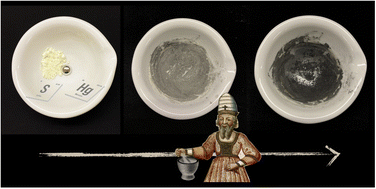“What makes every work perfect is cooking and grinding”: the ancient roots of mechanochemistry†
Abstract
This paper explores the historical significance of milling in various technological areas from ancient times, emphasizing its role beyond the simple ingredient reduction. The study focuses on sources from the 1st to the 10th centuries: philologists selected, studied, and translated ancient sources, while chemists provided chemical interpretations by replicating the recipes in the laboratory. The study delves into the synthesis of cinnabar from mercury and sulphur, or mineral ores such as orpiment, realgar, and stibnite. While the mercury–sulphur reaction is known, the synthesis from sulphide ores is not reported in the literature. Chemical replication assessed the reactions' feasibility and confirmed the fundamental role of grinding for the yield of the reaction, which was already recognized by the alchemist Zosimus of Panopolis (3rd–4th cent. CE) who claimed “what makes every work perfect is cooking and griding”.

- This article is part of the themed collection: RSC Mechanochemistry 2024 Hot Articles


 Please wait while we load your content...
Please wait while we load your content...